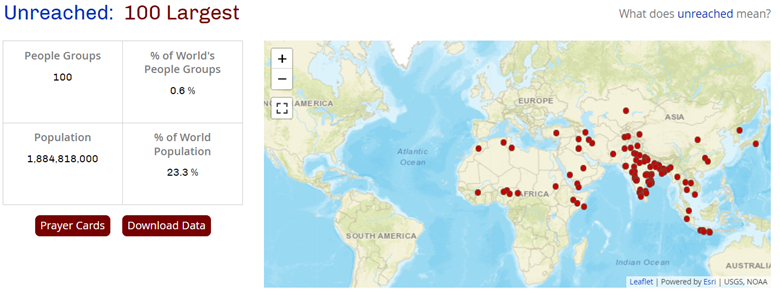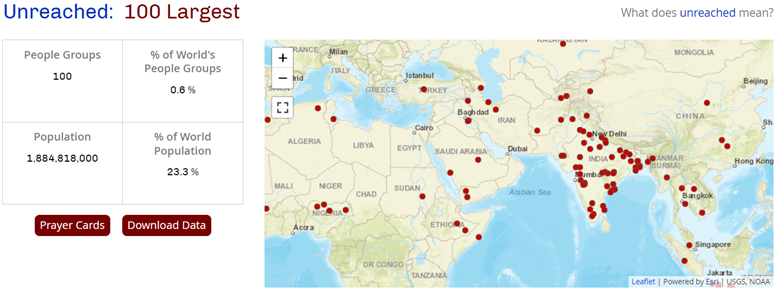
As we continue to reflect and work on transitioning responsibilities after Dr. Bijoy Roul’s passing, we think about the importance of the country of India for missions today. At first glance, the above graphic may look like nothing more than a confusing map of circles, with one country in orange jumping out. This post will explain the data behind this graphic and why India is arguably the epicenter of the remaining global missions task.
Missions strategies are often framed in the context of a people group, such as the Fulani people in Nigeria or Afghan refugees in the US. Those within a people group share a common affinity, such as language, religion, or ethnicity. Church planting movements generally spread amongst those within the same people group, as there are often barriers of understanding or acceptance between different people groups. This is why cross-cultural missions workers tend to focus their efforts on specific people groups.
Joshua Project estimates there to be around 17,400 distinct people groups in the world. Of these, there is a subset of them that are deemed to be unreached – these are called unreached people groups (UPG’s). Joshua Project defines UPG’s to have 5% or fewer Christians and 2% or fewer evangelicals. UPG’s do not have an indigenous community of believing Christians with adequate numbers and resources to evangelize the group without outside assistance. Another way to put it, UPG’s are the people groups which need outside missionaries to help provide gospel access to everyone within the group.
According to Joshua Project, as of July 2024, there are an estimated total 7,282 UPG’s, with an estimated total population 3,434,833,000 (42.5% of the world’s population).
Of these, a staggering 2,048 UPG’s, with an estimated total population of 16.9%, are in one country alone, India.
Here is a map of the 100 largest remaining UPG’s are in the world – do you notice one particular country where they are concentrated?

Here, the same map is zoomed in on the epicenter, India:

Frontier people groups: the highest priority UPG’s
Within the 7,282 unreached people groups (UPG’s) of this world is a subset of groups which represent those with the least gospel access. These are called Frontier people groups.
Joshua Project defines a Frontier people group as a UPG with virtually no followers of Jesus (less than 1 in 1,000; 0.1% or fewer) and no confirmed, sustained movements. In other UPG’s we can often find indigenous believers here and there, and missionaries can support and partner with these indigenous believers in their work. However, in Frontier people groups it is often not possible to find indigenous believers, and pioneering cross-cultural workers are still needed.
Of the 7,282 UPG’s, 4,893 are classified as Frontier people groups. The concentration of these in India is perhaps even more stunning:

India is home to 1,710 of the world’s 4,893 Frontier people groups. These groups have a total population of 1,040,529,000. In other words, half of the world’s remaining Frontier peoples are in India!
The Tide has been broadcasting in India since 1978 and today, we have, by far, more broadcasts in India (13) than any other country in the world. The Lord has placed us in this incredibly strategic position and we are honored to take part in the work of bringing the Gospel to the nations.
In future posts we will explore the strategic role that The Tide plays in contributing to the global effort reaching the remaining unreached and frontier people groups.
